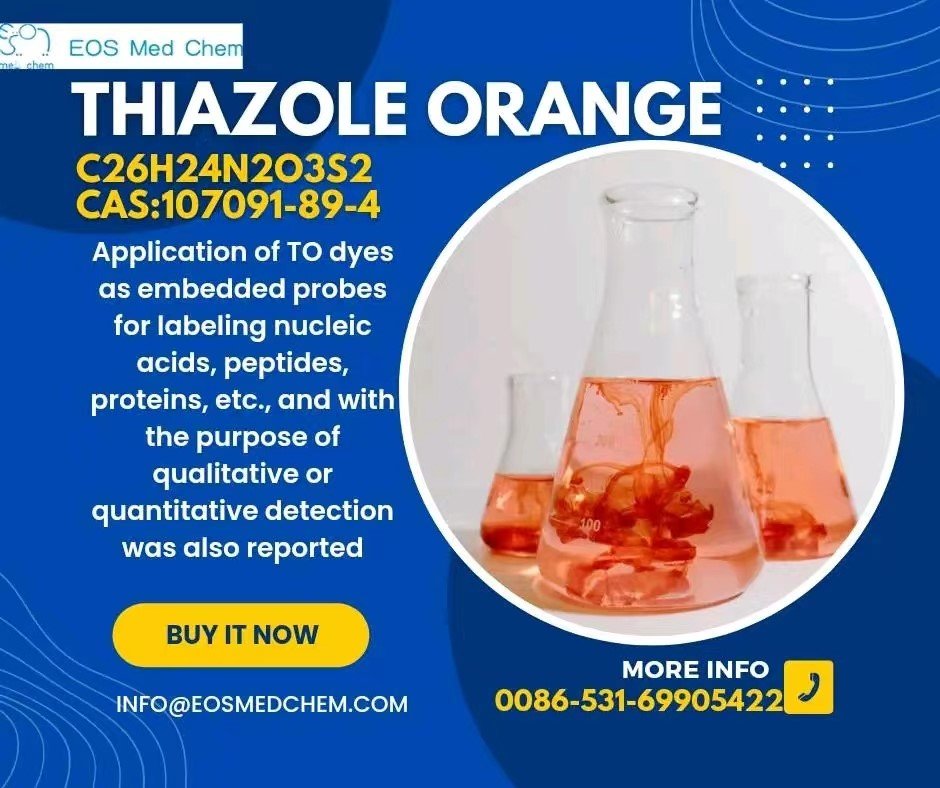Thiazole Orange,CAS No 107091-89-4: The Versatile Fluorescent Dye in Scientific Discovery
ali

Introduction to Thiazole Orange:
Thiazole Orange, identified by its CAS No 107091-89-4, stands out in the scientific community as a versatile and efficient fluorescent dye. Renowned for its applications in molecular biology and biochemical research, this thiazole dye has revolutionized the way scientists approach cellular and molecular studies.Thiazole Orange, with its distinctive CAS No 107091-89-4, is a chemical marvel in the realm of fluorescent dyes. This thiazole dye has carved a niche in the scientific community, revolutionizing molecular probes, fluorescence microscopy, and biochemical research.In the ever-evolving landscape of scientific research.This thiazole dye, characterized by its brilliant luminescence, has become an indispensable tool in the arsenal of modern science. It’s not just a substance; it’s a key that unlocks the mysteries hidden in the microscopic world. From the intricacies of molecular structures to the dynamic processes of cellular functions, Thiazole Orange has revolutionized our ability to observe and understand these minute yet critical aspects of biology and chemistry.Its journey from a mere chemical compound to a cornerstone in scientific visualization is a testament to the leaps of progress in chemical synthesis and application. Thiazole Orange has transcended its initial scope, emerging as a vital player in a variety of scientific fields. This dye has not only enhanced the resolution and clarity of fluorescence microscopy but has also become a crucial component in nucleic acid staining, playing a pivotal role in genetic research and diagnostics.As we navigate through the complexities of this fluorescent dye, we will uncover how Thiazole Orange has been harnessed to illuminate the previously unseen and bring clarity to the enigmatic nuances of molecular biology. Its impact extends beyond mere visualization; it aids in the understanding of life at a molecular level, contributing significantly to groundbreaking discoveries and innovations in science.The subsequent sections of this article will explore the chemical structure of Thiazole Orange, detailing the molecular foundations that bestow its unique fluorescent properties. We will also delve into its diverse applications, from its role in fluorescence microscopy and nucleic acid staining to its usage in various biochemical assays and biotechnological research. Furthermore, we will address the critical aspects of handling and safety protocols, ensuring this powerful tool is utilized with utmost care and
Chemical Properties of Thiazole Orange:
At its molecular core, Thiazole Orange, CAS No 107091-89-4 exhibits properties that make it an ideal candidate for a range of scientific applications. Its chemical structure allows it to act as a powerful fluorescent labeling agent, making it indispensable in both fluorescence microscopy and spectroscopy.Thiazole Orange is not just another fluorescent dye; it’s a beacon in the field of chemical analysis. Its molecular structure, featuring a unique blend of thiazole rings and chromophores, makes it exceptionally reactive to light, resulting in bright and stable fluorescence. This section will thoroughly explore its chemical properties and the principles behind its fluorescence.
Thiazole Orange in Fluorescence Microscopy:
In the field of fluorescence microscopy, Thiazole Orange, CAS No 107091-89-4 serves as a critical tool. Its ability to produce bright and stable fluorescence makes it a preferred choice for researchers studying cellular structures and functions. This section will delve into how Thiazole Orange enhances visualization in microscopy.Thiazole Orange has transformed fluorescence microscopy from a standard imaging technique to a high-definition exploration of cellular structures. Its ability to bind with biomolecules and emit intense fluorescence under specific wavelengths makes it invaluable in detailed cellular and molecular studies.
Nucleic Acid Staining with Thiazole Orange:
A key application of Thiazole Orange is in nucleic acid staining. Its affinity for DNA and RNA makes it an essential molecular probe in genetic analysis. This part of the article will focus on its role in DNA binding dye applications and how it aids in visualizing genetic material.In molecular biology, Thiazole Orange, CAS No 107091-89-4, is a game-changer for nucleic acid staining. Its high affinity for DNA and RNA, coupled with its low toxicity, allows for precise and efficient visualization of genetic materials. This part of the article will delve into the mechanics of its binding and the clarity it brings to genetic analysis.
Thiazole Orange in Biochemical Research:
Thiazole Orange’s contributions to biochemical research are vast. It is widely used as a laboratory reagent in various fluorometric assays and plays a pivotal role in cell viability testing and biological staining. This section will explore its applications in biochemical assays and its significance in laboratory settings.The role of Thiazole Orange, CAS No 107091-89-4 in biochemical research is multifaceted. It’s a staple in various fluorometric assays, contributing significantly to advancements in cell viability testing and biological staining. This section will discuss its applications in different biochemical assays and its importance in advancing laboratory research.
Thiazole Orange in Biotechnological Applications:
The use of Thiazole Orange, CAS No 107091-89-4 extends beyond basic research to biotechnological applications. Its versatility in fluorescent labeling and molecular biology reagents makes it a key player in advanced biotechnological research, aiding in complex studies and innovations.Beyond traditional research, Thiazole Orange,CAS No 107091-89-4, has profound implications in biotechnology. Its applications in fluorescent labeling and as a molecular biology reagent have opened new avenues in biotechnological innovations, playing a pivotal role in the development of advanced scientific solutions.
Safety and Handling of Thiazole Orange:
Despite its benefits, handling Thiazole Orange,CAS No 107091-89-4 requires caution. This part of the article will provide essential guidelines on the safe handling, storage, and disposal of this fluorescent dye in laboratory environments.Despite its benefits, handling Thiazole Orange, CAS No 107091-89-4, requires meticulous care. This segment will provide essential guidelines on the safe usage of this fluorescent dye, focusing on proper storage, handling techniques, and disposal methods to ensure safety in research environments.
Conclusion:Bright Future of Thiazole Orange
Thiazole Orange, CAS No 107091-89-4, is a cornerstone in the world of scientific research. Its diverse applications, from fluorescence microscopy to nucleic acid staining and biotechnological innovations, underscore its importance in advancing our understanding of the molecular world.Thiazole Orange, CAS No 107091-89-4, is much more than a fluorescent dye; it’s a key player in scientific discovery. Its wide-ranging applications in fluorescence microscopy, nucleic acid staining, and biotechnological research highlight its critical role in enhancing our understanding of complex biological systems.

